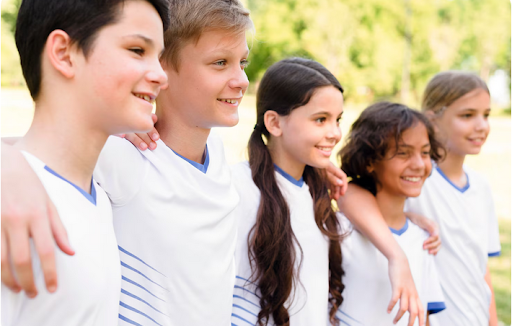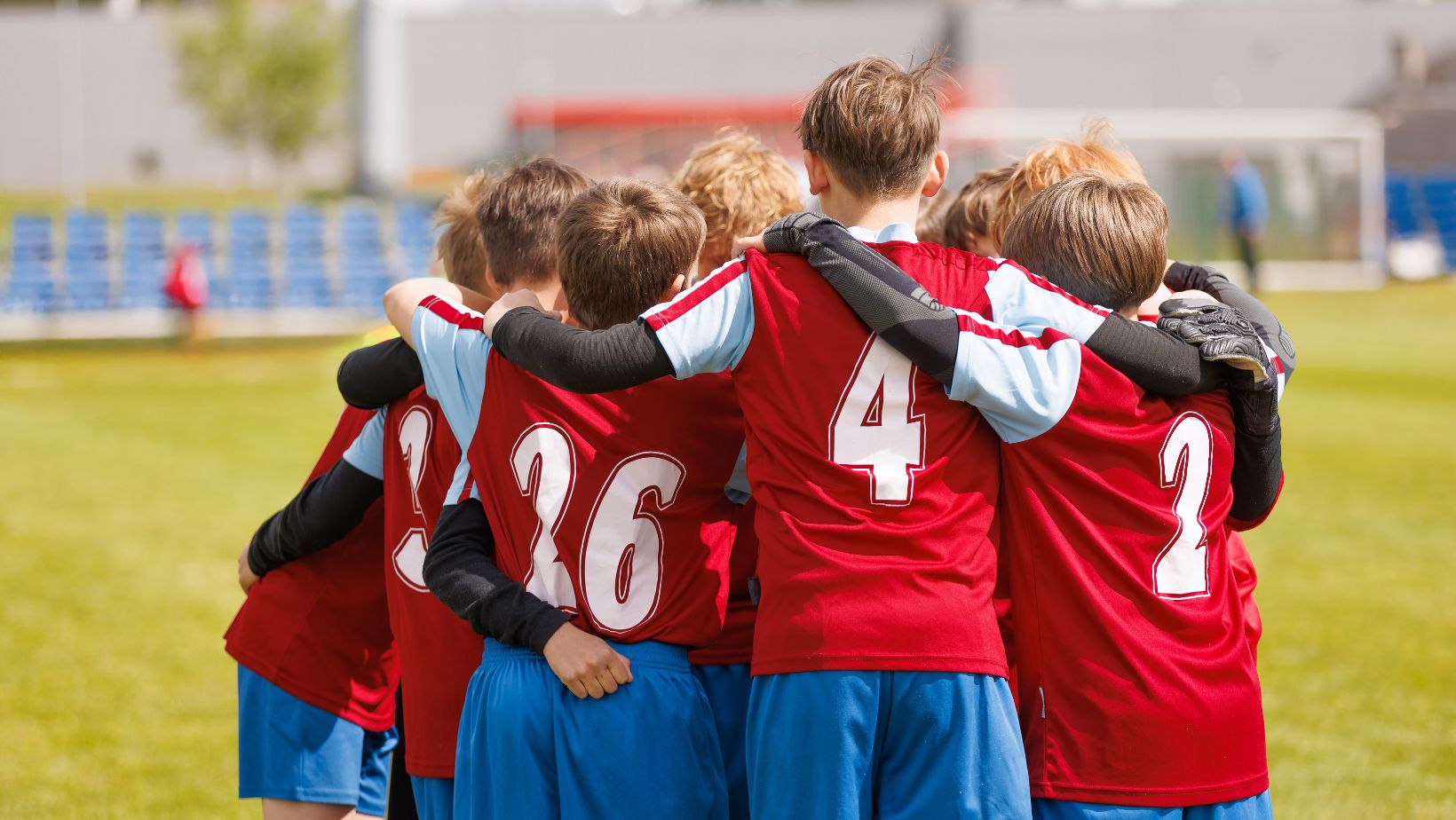Have you ever noticed how a simple team logo or uniform can instantly create a sense of belonging among young athletes? Visual design in youth and school sports goes far beyond just looking good – it’s about creating a powerful sense of identity that brings teams together and builds lasting connections.
Through thoughtful branding elements like uniforms, logos, and team colors, schools can foster an environment where young athletes feel proud to represent their team while developing strong bonds with teammates and supporters.
Whether on the field or in the hallways, these visual foundations help create an atmosphere of unity and school spirit that strengthens the entire athletic program and school community.
Unified Visual Elements as Foundations for Team Pride
Visual cohesion is crucial for forming a unified team identity in youth and school sports. Consistent uniforms, logos, and branding enhance visibility, build a recognizable image, and encourage pride among players and supporters.
Impact on Student Unity and Belonging
Research highlights that students view daily sport uniforms as simple, practical, budget-friendly, and visually appealing, which builds belonging and a sense of community.
- A study published in the NIH’s PubMed Central found “daily sport uniform wear was highly accepted, due to their visual appeal, simplicity and cost-savings relative to formal uniforms” and contributed to student comfort and confidence.
- Uniforms create unity and respect, allowing students to feel freer whilst wearing the sports uniform, which enhances engagement and school spirit.
A study by Rowland Hall School found that,
“Athletes and coaches consistently linked uniforms to increased unity, confidence, and team spirit, motivating players to perform better and feel greater pride in representing their team.”
The impact of visual elements extends beyond looks—they create a genuine sense of team spirit and belonging. Teams can stand out even more with custom-made football uniforms that showcase unique designs reflecting their identity.
Visual elements serve several key purposes in developing team culture:
- Creating instant recognition during games and events
- Fostering unity among team members
- Building connections with supporters
- Establishing a professional appearance
- Boosting confidence and team morale

East Stroudsburg University emphasizes in its Brand Manual that,
“Athletic logos and uniforms are designed for high visibility and consistent branding, establishing a powerful image both on the field and university-wide.”
These visual foundations help teams develop their unique character while promoting school spirit. When students wear their team colors, an atmosphere of excitement is created throughout the school community.
Brand Reach and Community Resonance
Strong visual branding in school sports creates a ripple effect that extends far beyond the playing field. When teams showcase consistent design elements across uniforms, banners, and social media, they build instant recognition within their community.
This unified approach helps establish a powerful presence that resonates with students, parents, and local supporters.
The impact of thoughtful visual branding shows up in several key areas of school athletics:
- Instant team recognition during games and events
- Increased fan engagement and attendance
- Higher merchandise sales for spirit wear
- Better student recruitment for sports programs
- More substantial social media presence and engagement
These visual elements create a distinctive identity that sets teams apart from their competitors. When schools invest in quality design across all platforms, they invest in brand awareness and community connection.
Local businesses often support teams with a more substantial visual presence, leading to valuable partnerships and increased resources for athletic programs.
Emotional Connections and Lasting Impact
A well-designed team brand creates deep emotional ties far beyond the playing field. Players with strong visual identities often develop lasting bonds with their teammates that stretch into adulthood.
The power of shared symbols, colors, and uniforms helps build connections between current players, alumni, families, and the broader school community.
Sports programs that blend cherished traditions with fresh design elements strike a perfect balance in their brand identity.
For instance, keeping classic team colors while updating uniform styles or logos can honor the past while staying current. This mix helps maintain the team’s authenticity while attracting new generations of athletes and supporters.
Here’s how thoughtful visual branding strengthens team relationships:
- Creates instant recognition and unity among team members
- Builds bridges between current players and program alumni
- Helps parents and families feel part of the team community
- Sparks pride and ownership in shared team symbols
- Makes game days and events more engaging for spectators
These visual elements spark emotional attachments that often last a lifetime. When athletes wear their team uniforms or see their school colors, it triggers positive memories and strengthens their commitment to the program.
This emotional investment often leads to continued support long after graduation, with former players returning as coaches, mentors, or dedicated fans.
Athletic Identity and Adolescent Development
Young athletes shape their identity through sports participation during crucial developmental years. How they connect with their athletic role is vital to their overall growth. This self-identification process happens naturally as students engage in team activities and adopt shared visual symbols, which foster a strong sense of belonging and athletic identity.
How visual elements support athletic identity development:
- Clear team symbols help athletes recognize their role within the group
- Consistent branding creates a sense of team unity
- Visual elements boost confidence during competitions
- Team colors and logos foster pride in representation
The impact of these visual elements extends beyond game day. Athletes carry their team identity into daily life, influencing their behavior, decision-making, and social connections. This connection to team visuals often leads to lasting positive associations with physical activity and competitive sports, supporting healthy lifestyle choices throughout adolescence and beyond.
Strategic Planning for Sustainable Success
Building a strong team brand requires careful planning and input from everyone involved. The process starts with setting clear goals and understanding what makes your team special.
Regular updates keep your team’s visual identity fresh and appealing. These changes don’t need massive overhauls; minor tweaks to colors, patterns, or design elements can make a big difference. Teams should consider current design trends while staying true to their core identity.
What makes a successful team branding strategy:
- Clear communication channels between decision-makers and team members
- Regular feedback sessions with players and coaches
- Consistent review of visual elements to ensure they remain relevant
- Balanced mix of traditional elements and modern design approaches
- Active participation from the school community in brand development
Getting everyone involved creates a sense of ownership and pride in the team brand. When students, coaches, and alumni feel they’ve contributed to shaping the team’s identity, they’re more likely to become passionate advocates for the program.
This collaborative approach helps create lasting traditions that future generations want to carry.
Pride Through Design
Visual design in youth and school sports goes beyond mere aesthetics – it’s a powerful tool for building lasting team identity and fostering genuine connections among athletes, coaches, and communities.
Through thoughtful implementation of visual elements like uniforms, logos, and consistent branding, teams create an environment where young athletes can develop confidence, pride, and a strong sense of belonging.
The impact of well-executed visual design in sports extends well into adulthood, shaping memories, relationships, and personal growth while creating traditions that unite generations of athletes.




